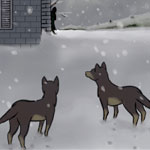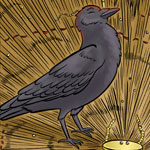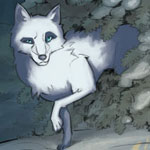Fauna

Bas Rouge
The bas rouge is a large, athletic working dog used as a guard dog and for herding sheep or cattle. As an adult, the bas rouge stands 61 to 70 centimeters (24 to 28 inches) in height and weighs 30 to 50 kilograms (65 to 100 pounds). Their standard coloring is black and tan with reddish feet, which gives the breed its name. They live for ten to twelve years on average. Highly intelligent, obedient, and eager to please, bas rouge quickly understand and respond to their masters' commands. Adults are typically suspicious of strangers and make excellent guard dogs. They must be socialized very thoroughly when young to combat aggressive tendencies.
Beaver
“The beaver is the most productive of all animals. It makes kettles, hatchets, knives, beads, and cloth.”
-Kichanabe, Chief of the Elakanois
The beaver is a semi-aquatic rodent that can be found across Everique, especially in the northern regions. When the Age of Discovery dawned, the beaver numbered in the tens of millions. They are best known for building dams across the many small waterways, and their rich and lush fur is a highly sought-after commodity and the basis of the fur trade.
An adult beaver weighs around 20 kilograms (45 lbs). It lives with only one mate and their cubs, which are born in the month of Blossom. The young cubs live with their mother for only six weeks, but may stay in the lodge for one year. They are taught to swim by their father within 48 hours. The cubs reach full growth in two and a half years. Beavers are herbivores, eating water plants and wood from trees.
Beavers are great construction workers. They build dams across streams to ensure a supply of water for food and protection. They then build a lodge out of sticks, branches, and small stones cemented together with mud. Inside the lodge is a circular chamber that is reachable by two secret, underwater entrances. An average beaver lodge has about nine family members living in it. Beavers will vigorously defend their territory against intruders. They leave scent mounds to mark their territory, and, when threatened, they slap their flat tail on the water as a warning signal to other beavers.
Beavers do not hibernate and grow thick fur coats. Those in the far northwest of the Lakelands have thicker, darker, and more beautiful coats than their cousins in the south. Beavers have two different types of hair — an outer guard hair and a shorter fur underneath. Both types of hairs have little barbs that makes the beaver's fur so desirable for the manufacture of hats, as the fur creates a dense-packed felt that is nearly waterproof. The best grade of fur is the greasy beaver. These furs have been worn as coats by the natives and become saturated with body oil and grease from cooking fires. The movements of the wearer loosened the outer guard hairs, laying bare the underfur. This fat-saturated fur became the most desired material in the hatter's trade.
The Saronnans leave the trapping of the beaver to the natives who use deadfall traps, nets, and occasionally dogs. Winter pelts bring the best prices, so the hunting usually takes place in the cold months. A good hunter might take fifty to sixty pelts between Paintedleaf and Tearfall.

Crow
Crows are common birds in all parts of the world. They are all black, including their legs and bill. They have a heavy straight bill, long legs, and a thick neck. Crows are very social birds and live in large extended families, called murders. Crows rarely fight other crows within a murder, but will fight crows from other murders. They commonly mate for life. Crows are omnivorous, eating everything up to and including carrion. Their persistence makes them a nuisance to farmers, as they will eat freshly planted seeds or young seedlings.
Crows are an adaptable and opportunistic species. Crows are remarkably intelligent, and legends abound that they know how to count, can recognize human beings by sight, and will warn other crows about humans who are a threat. Crows are aggressive, and in groups, they will chase away larger birds. They particularly hate owls, because owls will eat crows. If a murder discovers an owl, they will harass the owl by mobbing it until it leaves the area.
The natives of the northeastern woodlands of Everique generally consider the crow to be a bad omen. It represents darkness and impending death, but it can also represent opportunity and adaptability. As a spirit animal, the crow is a mean-spirited trickster spirit that punishes the wicked and mocks the self righteous with its incessant cawing. The legends and symbolism of crows is often confused with that of ravens.

Fox
Foxes are omnivorous mammals found throughout Corthis. They are identifiable by their triangular ears, upturned snout, and bushy tail. They are distantly related to wolves and dogs, but are smaller than those animals. Foxes come in many breeds. The most common in Everique is the red fox, named for its auburn pelt. The northern reaches of Everique is the home of the arctic fox, who has a snow-white pelt. Foxes commonly live in small groups called skulks, but the arctic fox is often solitary. While fox hides are not as valuable as beaver pelts, trappers harvest fox hides as part of the fur trade.
When they fight, foxes prefer to pounce with surprise, landing atop their prey. The sounds of a fox is often unnerving to humans, especially their scream during the mating season. When fighting, they make a sound called gekkering, an onomatopoeic term based on the gek-gek-gek sound the foxes make.
In the beliefs of the natives of the northeastern woodlands of Everique, the fox is a good spirit but a bad sign. If a fox makes an appearance, the witness is sure to have great challenges ahead. However, the fox is a wise and noble messenger who will help people solve their problems, if they are humble and ask for help. Some legends show the fox punishing the careless and the arrogant, but always as a method of teaching.
« Return to the Almanac Index


